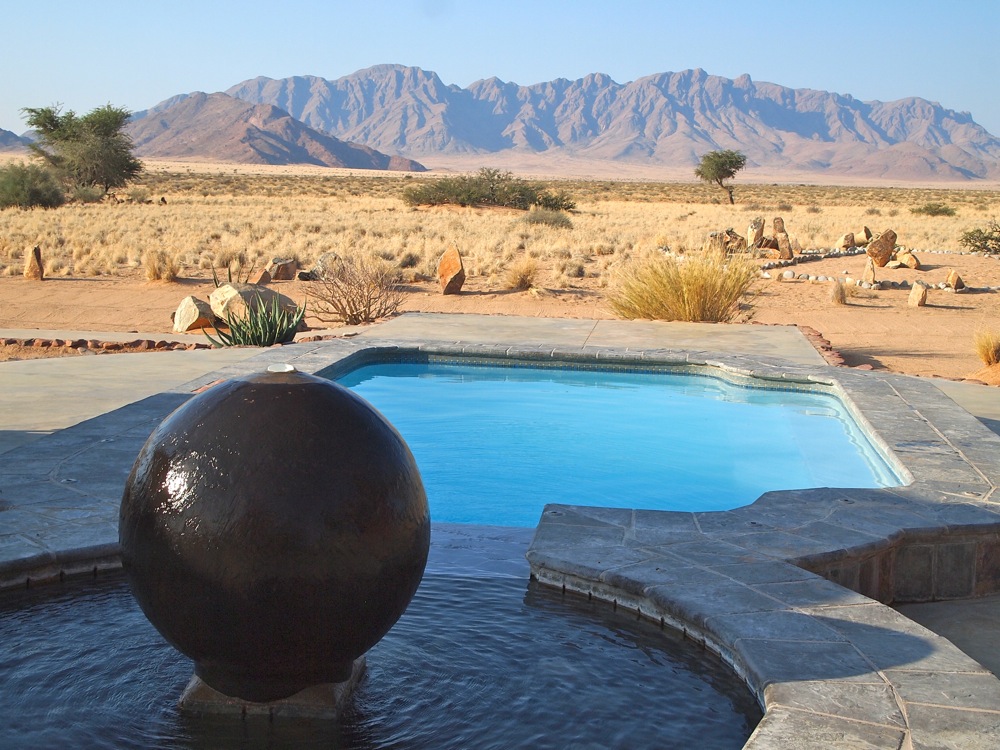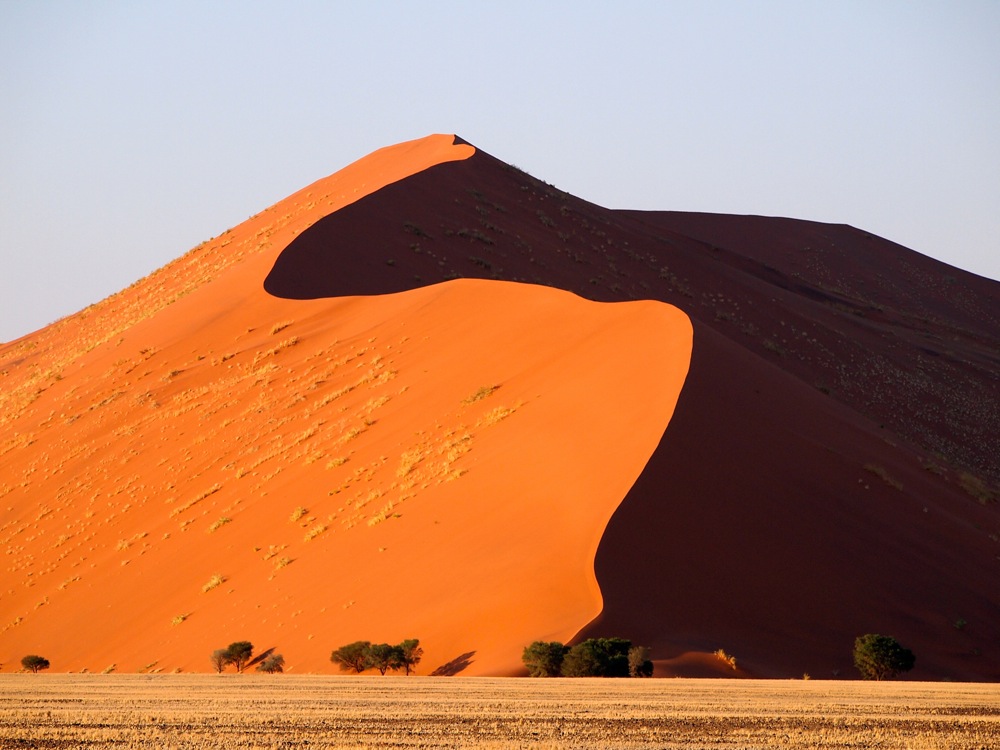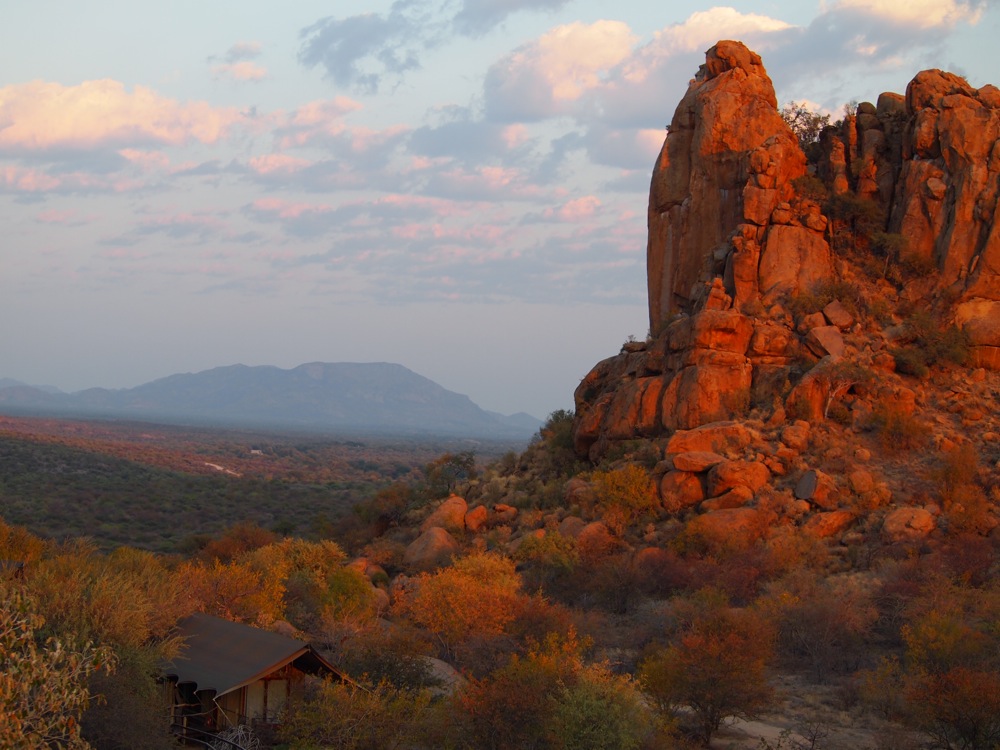I’ve come to the end of an exciting and varied nine days in this beautiful, sparsely populated country. With only 2.2 million people (to Tanzania’s 45 million), Namibia has the lowest population density of any country in Africa and the second lowest in the world (after Mongolia). The emptiness and open spaces combined with the variety of natural landscapes is a unique and wonderful combination. In addition, the tourist infrastructure is quite good so there are terrific places to stay.
A Rough Start
However, this chapter of my travels had a hard start. My friend Anne arrived the day after I did and we had a lovely first dinner at NICE, the Namibia Institute of Culinary Education.
The next morning, a Sunday, Anne had her purse stolen (interesting story how it happened but not how I want to spend my blog time) so we had to spend an extra night in the Windhoek to file police reports and to allow Anne to go to the US Embassy to order a temporary passport.
By mid-morning Monday, we were once again ready to head off. Within an hour, with me driving, we had a very scary car accident that included several 360’s on the B1 southbound highway, a damaged vehicle, but luckily no injuries. My fault, I’m afraid, and Anne decided she needed a couple days to recover and regroup so she headed back into Windhoek. Meanwhile, with a new 4X4 from the rental company, I proceeded to Zebra River Lodge in the dramatic Tsaris mountains.
The Tsaris Mountains
My drive was a long one and for the last hour and a half of it, I was driving in the dark (and I mean totally dark), a “no-no” in an area with a lot of wild game that come out at night. Attracted by car headlights, they cross the road as though they have a death wish. One rabbit and two kudu ran in front of my vehicle and while the rabbit would be just a nauseating thump if I hit it, the kudu could have been a life or death experience (and I’d already had one of those that day).
Luckily, as I’d been warned, I was on the lookout and therefore quick enough with the brakes so that all three animals that ran in front of my car made it across the road. The next morning, I took a guided hike and got a good look at the geology of what was an ocean a long, long time ago resulting in the amazing layers that make up the mountains.
The Desert
Leaving the mountains, I drove a manageable hour and a half to Desert Camp, my “glamping” (glamour camping) home for two nights near Sossusvlei, the area filled with beautiful, sculptural mountains and dramatic orange dunes for which Namibia is so famous.
Many springbok, the South African national animal, and oryx, a much larger antelope with two long, straight horns, live in this area, along with the funny ostrich with very strong legs that allow them to outrace cars if they so choose along the highway. My dinner each night at the Sossusvlei Lodge featured numerous kinds of game meat I could choose to have grilled for me including eland, oryx, springbok, ostrich, kudu, crocodile, and zebra.
At 6:30am the next morning, I was off on a tour of the dunes and they really are spectacular. The orange color is due to iron oxide and is found only in this area. After driving by and admiring many dunes, we continued on to “Big Daddy,” the tallest of them all at between 350 and 400 meters and climbed part way up.
After our climb up and run down the dune and some time spent in Deadvlei with its 600-year-old petrified trees, the guide drove us to Sossusvlei itself where the trees are green as they are fed by a vast underwater stream that is 150 to 200 meters below the surface (imagine those roots). He set up a luxurious breakfast for the five of us on a white tablecloth covered picnic table. What a treat after all that climbing.
Happily, Anne had by now recovered her nerve, gotten her replacement passport, and arrived at our next stop at Swakopmund on the Atlantic coast. While I drove for many hours on a washboard dirt road to get there from the desert, Anne had a wonderful kayaking trip surrounded by hundreds of seals and flamingos.
The next morning, it was time for my sand-boarding adventure. It has been at least three years since I’ve snowboarded but I hoped it would come back to me enough that I could enjoy the stand up boarding and not just the sliding down on the stomach version. I did five runs on the snowboard, meaning I had to climb up the dune five times (phew!) and one run on the stomach board (hitting 68 km/hr). Both were really fun and while I didn’t manage a clean run on the snowboard, I was able to carve lots of decent turns. I know that if I’d had a few more runs, I would have gotten it down! The dunes in which I was boarding were gorgeous, though not orange, lacking the iron oxide of the Sossusvlei area.
Anne went off and looked for desert insects while I sweated up and down the dune. Ironically, Beth, who runs the boarding operation and has lived in Namibia for 18 years, is from Marin county!
The Erongo Mountains
The last stop on our tour before returning to Windhoek was in the Omaruru area to stay at a spectacular place called the Erongo Wilderness Lodge. Situated amongst huge boulder strewn kopjes (rock hills), the lodge is made of luxurious tent cabins perched on top of the rocks. The main lodge has a restaurant area, decks, a pool built into the rocks and all surrounded by the dramatic views. It’s a place to remember and clearly well managed by owner manager, Roger, who happened to be present during our visit.
Erongo Wilderness Lodge, our cabin in lower left of photo
Between my guided morning hikes and the evening game drive, I saw a host of game and birds including a large group of Hartmann mountain zebra, a family of dik-dik (small, charming antelope with big eyes), klipspringer (rock jumping antelope), lots of baboons and dassies (hyrax), go away birds, rosy faced love birds, double banded sand grouse, crimson breasted shrike, a Damara hornbill, African hawk eagle, and the freckled nightjar.
Overall, despite the very tough beginning to this week, I’ve loved Namibia, both because of the feeling of space and emptiness after the press of so much humanity in Tanzania and Zambia and, of course, due to the dramatic, picture worthy landscapes. I hope I’ll be back very soon for a more complete tour!
I’m now in my last few days in Africa, visiting Zinkwaze Beach on the Kwa-Zulu Natal coast of South Africa with Anne, and will be in Montreal by the end of the week for Kelsey’s graduation from McGill on Monday. I will return to California next week – so I am almost “Out of Africa.”









Ok, as a consequence of this blog, I’m now vegetarian.
incredible photos! Some of them are so surreal, they look like paintings. Beautiful.
Can’t believe your adventure is nearly over! Seems so quick, at least as a side-watcher.